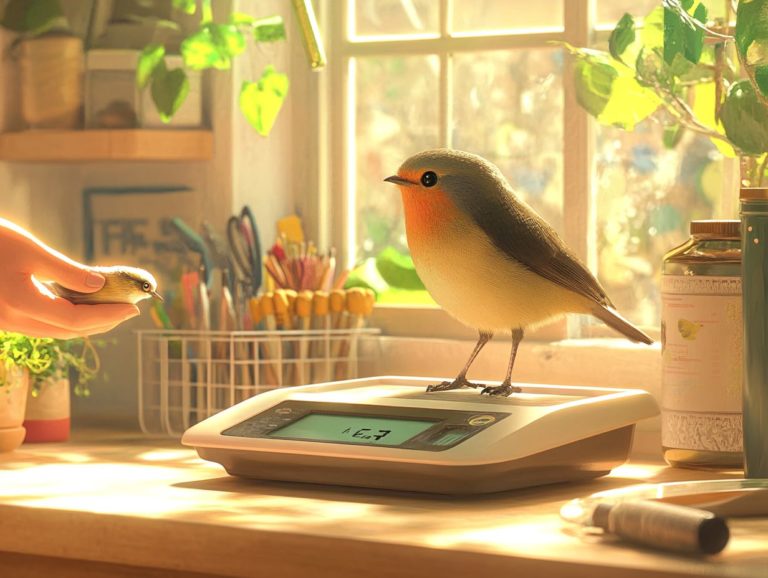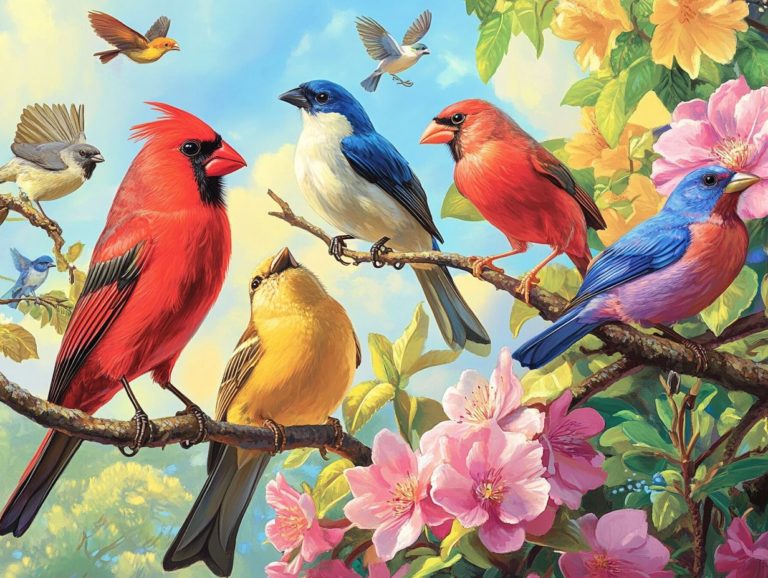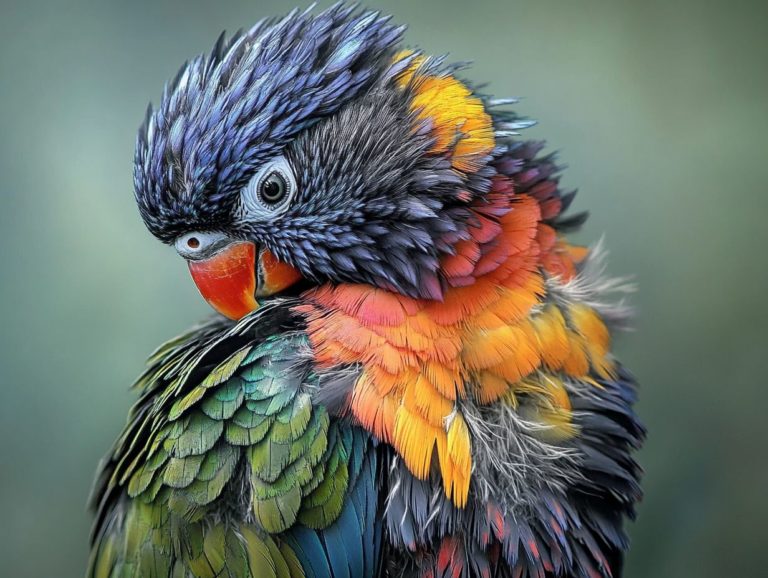How to Support Your Bird During Hot Weather
As temperatures soar, your feathered friends encounter distinct challenges in their quest to stay cool. Grasping how they regulate their body temperature is vital for ensuring their overall well-being.
This article delves into the signs of heat stress, offering practical tips to create a comfortable environment for your bird while highlighting the indispensable role of hydration.
It also provides guidance on managing heat-related emergencies and shares year-round strategies to keep your pet safe and healthy in an increasingly warming world. Your pet’s comfort begins right here!
Contents
- Key Takeaways:
- How Birds Beat the Heat!
- Spotting Heat Stress Signs in Birds
- Make a Cozy Haven for Your Birds This Summer!
- Handling Heat-Related Emergencies
- Preparing for Hot Weather
- Frequently Asked Questions
- What are the signs that my bird is struggling in hot weather?
- How can I help my bird stay cool in hot weather?
- Should I give my bird ice cubes to cool down?
- Can I safely take my bird outside when it’s hot?
- What should I do if my bird shows signs of heatstroke?
- How can I prepare my bird for hot weather before it arrives?
Key Takeaways:

- Provide a cool environment for your bird to prevent heat stress. This includes access to shade, proper ventilation, and misting their feathers with water.
- Watch for signs of heat stress, like panting, lethargy, and loss of appetite. Act fast by moving your bird to a cooler area and providing fresh water.
- Keep hydration levels up by offering fresh water daily and consider adding electrolyte supplements for added hydration and balance.
How Birds Beat the Heat!
Understanding how birds cope with heat is essential, especially during the sweltering summer months when temperatures soar. These conditions can be formidable challenges for various avian species. Heat management is vital for their survival and well-being as they adapt to climate change and fluctuating humidity levels.
Many birds have fascinating adaptations that allow them to navigate extreme weather. They use innovative ways to cool down, such as panting, bathing, and seeking shade to regulate their body temperature.
How Birds Regulate Body Temperature
Birds employ a variety of strategies to keep cool during those hot summer days. They utilize both physiological mechanisms and behavioral adaptations.
Take the American robin, for example. This bird relies on evaporative cooling through panting, which allows moisture from its respiratory surfaces to dissipate heat effectively. Then there s the African grey parrot, which showcases its cleverness by taking baths. This not only keeps its feathers clean but also provides a refreshing cooling effect as the water evaporates.
The structure and arrangement of feathers play a crucial role in these cooling processes. Consider the peacock’s feathers designed to reflect sunlight while providing insulation to maintain a stable body temperature. These combinations of strategies highlight the remarkable adaptability of birds as they face environmental challenges.
Spotting Heat Stress Signs in Birds
Spotting heat stress signs in birds is crucial for their health. Extreme temperatures can lead to dehydration and serious issues.
Being vigilant allows you to take proactive steps to ensure their safety and comfort in challenging conditions.
Identifying Symptoms and Warning Signs

Identifying the symptoms and warning signs of heat stress in birds is an invaluable skill for you as a bird caregiver or wildlife enthusiast.
When you notice increased panting, drooping wings, or shifts in appetite, it s essential to recognize that these signs may indicate a bird in distress. Spotting these symptoms early allows you to take immediate action, which could be crucial in preventing life-threatening situations. Being attuned to these changes not only aids individual birds but also plays a significant role in broader conservation efforts for avian species. Timely interventions can greatly enhance their chances of survival in our ever-changing climate.
Educating yourself on these vital signs fosters a deeper connection with wildlife and underscores the importance of safeguarding our feathered friends from environmental threats.
Make a Cozy Haven for Your Birds This Summer!
Creating a safe and comfortable environment for your birds during the sweltering summer heat is vital for their health and well-being. By taking the necessary steps, you ensure they can thrive even when temperatures soar.
Tips for Creating a Cool Environment
Creating a welcoming environment for birds requires a mix of physical changes and smart strategies to keep them comfortable in the summer heat. Shaded areas with natural plants can offer relief from the sun.
Place birdbaths in key spots. This provides a refreshing oasis for cooling off and attracts various bird species looking for water. Ensure fresh water is available throughout the day to boost their well-being.
By growing a variety of native plants, you support the natural balance in your backyard, which helps local wildlife thrive.
This environment also attracts beneficial insects that sustain the ecosystem, which is crucial for all species involved.
Importance of Proper Hydration
Hydration is vital for birds, especially in extreme temperatures. When birds get dehydrated, they can become very stressed, affecting their social life and feeding habits.
A dehydrated bird may seem tired or irritable and may avoid others. This disrupts their natural behaviors.
Make sure birds have easy access to clean, fresh water, especially on hot days. Place multiple water sources around their area. Shallow bowls are best, as they are easy to use.
Handling Heat-Related Emergencies

When temperatures soar, being prepared for heat-related emergencies can be life-saving. Quick action and basic care steps are essential for keeping birds safe.
First Aid for Heatstroke and Dehydration
Knowing how to handle heatstroke and dehydration is important for bird caregivers. This knowledge helps you act fast when you see symptoms.
Be alert for signs of heatstroke in birds, which can include excessive panting, drooping wings, or lethargy. Early detection is key to reducing risks.
If a bird shows these signs, offer cool water to hydrate it and move it to a shaded or air-conditioned spot. Applying cool, moist cloths can help lower its body temperature.
Taking prompt action can greatly improve outcomes, so stay attentive and informed about these essential care steps.
Preparing for Hot Weather
Get ready for hot weather by implementing year-round strategies. This ensures birds have refreshing spots and safe habitats during the hottest months.
As climate change causes more temperature swings, creating environments where birds can thrive is more important than ever.
Year-Round Strategies for Keeping Your Bird Cool
Implementing strategies throughout the year not only protects your bird’s health but boosts its overall well-being. Establish a consistent summer routine with outdoor aviaries for a stimulating environment.
Regularly check humidity levels, as too much moisture can harm their health. Make adjustments to ensure proper ventilation and shade, which can lower stress and keep birds comfortable.
These thoughtful changes promote optimal living conditions and encourage a more active, healthy lifestyle for your pet birds.
Frequently Asked Questions

What are the signs that my bird is struggling in hot weather?
Some signs that your bird is struggling in hot weather include panting and holding their wings away from their body. If you see these signs, take action to help your bird cool down.
How can I help my bird stay cool in hot weather?
To help your bird stay cool, provide plenty of fresh water for drinking and consider including hydration tips for your pet bird by offering access to a shallow dish or birdbath for bathing.
Place a fan near their cage to create a breeze and provide shade if their cage is outside.
Should I give my bird ice cubes to cool down?
No, you should not give your bird ice cubes. Birds cannot regulate their body temperature like humans, and a sudden drop in temperature can be harmful.
Can I safely take my bird outside when it’s hot?
It is generally unsafe to take your bird outside when the temperature exceeds 85 degrees Fahrenheit. Birds can easily get too hot, so keep them indoors in a cool, shaded area during hot weather.
What should I do if my bird shows signs of heatstroke?
If your bird shows signs of heatstroke like heavy panting or struggling to breathe act fast! Move them to a cooler spot and offer fresh water.
If their condition does not improve, seek immediate veterinary care.
How can I prepare my bird for hot weather before it arrives?
To prepare your bird for hot weather, ensure they have access to plenty of fresh water at all times. Additionally, offering fruits and vegetables with high water content, such as cucumber or watermelon, can also help. It’s important to know how to support your bird’s recovery after illness to keep them healthy during the heat.
Provide a shallow dish of water for bathing and ensure their cage is in a cool, shaded area.






